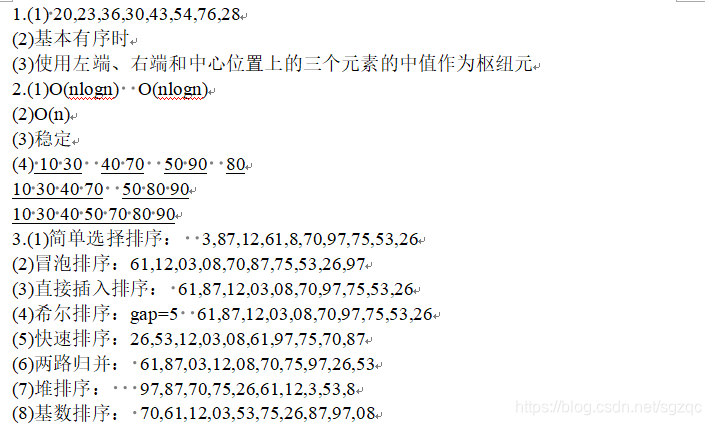数据结构与算法分析(C++语言版)_张琨版 第九章排序课后习题答案
一、选择题1.B 2.B3.A4.B C5. A6.A7.D8.A9.C10.C二、填空题170,275,154,503,512,765,612,897,512,677,908堆排序快速排序n-1O(nlogn)希尔排序快速排序堆排序60,51,121,142,15,575,185,46,57,68,89n+2)(n-1)/29,15,7,8,20,-1,4简单选择排序13三、判断题× 2. √
一、选择题
1.B 2.B 3.A 4.B C 5. A 6.A 7.D 8.A 9.C 10.C
二、填空题
- 170,275,154,503,512,765,612,897,512,677,908
- 堆排序 快速排序
- n-1
- O(nlogn)
- 希尔排序 快速排序 堆排序
- 60,51,121,142,15,575,185,46,57,68,89
- n+2)(n-1)/2
- 9,15,7,8,20,-1,4
- 简单选择排序
- 13
三、判断题
- × 2. √ 3. × 4. × 5. × 6. × 7. × 8. × 9. ×10. √
四、简答题

-
(1)直接插入排序 简单选择排序 冒泡排序 希尔排序 折半插入排序 快速排序
(2)堆排序 希尔排序 快速排序 两路归并排序
(3)直接插入排序 简单选择排序 冒泡排序 堆排序 希尔排序 折半插入排序
(4)堆排序 希尔排序 快速排序

平均时间复杂度O(d(n+r)) 空间复杂度O(n+r)
其中d为关键字位数 r为基数 n为关键字个数
五、计算题
- 思路】先从底向上从无序区冒一个最小的元素,在从上向底从无序区冒一个最大的元素。算法如下:
void DBubble(SqList R[],int n)
{
int i,j;
SqList temp;
int exchange=1;
i=0;
while(exchange==1)
{
exchange=0;
for(j=n-i-1;j>1;j--)
{
if(R[j].key<R[j-1].key)
{
exchange=1;
temp=R[j];
R[j]=R[j-1];
R[j-1]=temp;
}
}
for(j=i;j<n-1;j++)
{
if(R[j].key>R[j+1].key)
{
exchange=1;
temp=R[j];
R[j]=R[j+1];
R[j+1]=temp;
}
}
i++;
}
}
- //折半插入排序
void Binsert_sort(ElemType array[],int length){
int inner,outer,i;
int temp,position;
int low,high,median;
if(array == NULL || length == 0)
exit(-1);
for(outer = 1; outer < length ;outer++){
//取出待插入元素
temp = array[outer];
low = 0;
high = outer - 1;
//查找插入位置
while(low <= high){
median = (low + high) >> 1;
if(array[median] < temp)
low = median + 1;
else
high = median - 1;
}
position = low;
//相应元素后移
i = outer;
while(i > position){
array[i] = array[i-1];
i--;
}
//将待插入元素插入到position
array[position] = temp;
}
}
- 解析:

代码:
void counting_sort(int *ini_arr, int *sorted_arr, int n)
{
int *count_arr = (int *)malloc(sizeof(int) * NUM_RANGE);
int i, j, k;
//统计数组中,每个元素出现的次数
for(k=0; k<NUM_RANGE; k++){
count_arr[k] = 0;
}
for(i=0; i<n; i++){
count_arr[ini_arr[i]]++;
}
for(k=1; k<NUM_RANGE; k++){
count_arr[k] += count_arr[k-1];
}
for(j=n-1 ; j>=0; j--){
int elem = ini_arr[j];
int index = count_arr[elem]-1;
sorted_arr[index] = elem;
count_arr[elem]--;
}
free(count_arr);
}
- (1)代码如下:
#include<iostream>
using namespace std;
typedef int KeyType;
typedef struct node
{
KeyType key;
struct node * next;
}SNode;
void createLink(SNode *&h, KeyType R[], int n)
{
int i;
SNode *s, *r;
h = (SNode *)malloc(sizeof(SNode));
r = h;
for (i = 0; i < n;i++)
{
s = (SNode *)malloc(sizeof(SNode));
s->key = R[i];
r->next = s;
r = s;
}
r->next=NULL;
}
void InsertSort(SNode *&h)
{
SNode *p, *p1, *q, *pre;
if (h->next)
{
p = h->next->next;
h->next->next = NULL;
while (p)
{
pre = h;
q = pre->next;
while (q && q->key<p->key)
{
pre = q;
q = q->next;
}
p1 = p->next;
p->next = pre->next;
pre->next = p;
p = p1;
}
}
}
void Display(SNode *h)
{
SNode *p = h->next;
while (p!=NULL)
{
cout << p->key << " ";
p = p->next;
}
cout << endl;
}
int main()
{
int a[] = { 30, 10, 70, 50, 70, 60 };
int n = sizeof(a) / sizeof(a[0]);
SNode *h;
createLink(h, a, n);
cout << "排序前:" << endl;
Display(h);
InsertSort(h);
cout << "排序后:" << endl;
Display(h);
return 0;
}
(2)
10,30
10,30,70
10,30,50,70
10,30,50,70,70
10,30,50,60,70,70
(3) 最好情况下为O(n)
六、说明
本人已毕业多年,读研时撰写了一份 《数据结构与算法分析(C++语言版)_张琨版 课后习题答案》,每年依旧有大量考研的学弟学妹们来找这份答案,现将其公布在blog上,仅供学术交流,上述解答如有问题,可私信沟通。

魔乐社区(Modelers.cn) 是一个中立、公益的人工智能社区,提供人工智能工具、模型、数据的托管、展示与应用协同服务,为人工智能开发及爱好者搭建开放的学习交流平台。社区通过理事会方式运作,由全产业链共同建设、共同运营、共同享有,推动国产AI生态繁荣发展。
更多推荐
 已为社区贡献3条内容
已为社区贡献3条内容








所有评论(0)